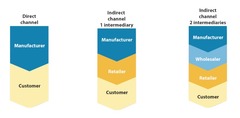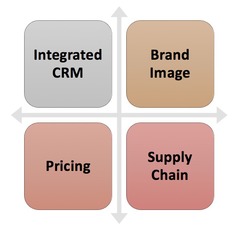(Week 9) Supply Chain, Channel Management and Retail – Flashcards
Unlock all answers in this set
Unlock answersquestion
1. Importance of Supply Chain Management
answer
- Marketing channels allow companies to get their products in the appropriate outlets in sufficient quantities to meet consumer demand. To anticipate this demand, advertising and promotions must be coordinated with the department that controls inventory and transport. Otherwise customers would come in seeking a promotion and not find the product. - Without a marketing channel, consumers would be forced to find raw materials, manufacture products and somehow get them to where they could be used, all on their own.
question
2. Direct vs. Indirect Marketing Channels

answer
- There are two main ways by which businesses get their goods to consumers. 1. Direct Marketing Channel - Using a direct marketing channel, a customer can purchase goods from the manufacturer without needing to go through a retailer or intermediary, generally online or at company stores (e.g. Apple). 2. Indirect Marketing Channel - More commonly, manufacturers choose to offer their goods to consumers through an intermediary, such as a retailer (e.g. Woolworths), implementing an indirect marketing channel strategy.
question
3.1. Vertical Marketing Systems (Method 1)
answer
The more closely aligned the marketing channel members are with each other, the less likely there will be significant conflict. 1. Administered Marketing Channel - An administered marketing channel occurs when a dominant and powerful marketing channel member has control over the other members. 2. Contractual Marketing Channel - In a contractual marketing channel (e.g. franchising), coordination and control are dictated by contractual relationships between members. 3. Corporate Marketing Channel - Corporate marketing channels can operate relatively smoothly because one firm owns the various levels of the chains.
question
3.2. Strategic Relationships (Method 2)
answer
Marketing channels also can be effectively managed through strong relationships developed with marketing channel partners. To create such relationships, the partners must trust each other, communicate openly, have compatible goals, realise there is benefit in being interdependent and be willing to invest in each other's success.
question
4. Factors affecting the establishment of relationship with retailers

answer
1. Choosing Retailing Partners - When they initiate the decision process for choosing retail partners, manufacturers determine how likely it is that certain retailers would carry their products and whether target customers expect to find their products for sale at those retail locations. 2. Identifying types of retailers - Next, manufacturers need to identify types of retailers that would be appropriate locations for their products. 3. Develop a retail strategy - After identifying likely and appropriate retailers, manufacturers work with their retailer partners to develop a strategy. 4. Managing Multichannel Strategy - Finally, manufacturers, again with their retail partners, must determine which elements of a multichannel strategy will be effective. Manufacturers often make these decisions simultaneously or in varying orders.
question
4.1. Choosing Retailing Partners (Step 1)

answer
1. Channel Structure - Manufacturers often start by noting the basic channel structure, which includes the level of vertical integration, the relative strength of the retailer and the manufacturer and the strength of the brand. 2. Customer Expectations - They also consider where their target customers expect to find products, which depends largely on the retailer's image. 3. Channel Member Characteristics* - Channel member characteristics also are important inputs, as is the level of distribution intensity.
question
4.1.1. Distribution Intensity (Channel Member Characteristics)
answer
1. Intensive Distribution - Intensive distribution intensity means the product is available virtually everywhere, in as many places as will agree to carry it. 2. Exclusive Distribution - In an exclusive distribution intensity strategy, the manufacturer allows only one retailers (or retail chain) in each area to sell its products. 3. Selective Distribution - Selective distribution is the middle ground option; several retailers carry the products, but not all of them.
question
4.2. Types of retailers (Step 2)
answer
- Retailers generally fall into one of three categories: food retailers, general merchandise retailers or service retailers. - Each of the categories consists of various formats, including supermarkets, supercentres, warehouse clubs, convenience stores, department stores, discount stores, specialty retailers, chemists, category specialists, extreme-value retailers and off-price stores. - Although service retailers primarily sell services, if they sell to consumers, they are still retailers. Service retailers span the gambit from universities to service stations.
question
4.3. Develop Retailing Strategy (Step 3&4)
answer
1. Store vs. 2. Multichannel Marketing (Store + Online)
question
4.3.1. Store (1st Strategy)
answer
- Benefits: 1. Because consumers often have just a general idea of what they want to purchase, stores' main benefits come from giving shoppers a place to browse. 2. They can touch and feel products, obtain personal services, pay using cash or credit, engage in an entertaining and social experience, receive instant gratification and reduce their sense of risk.
question
4.3.2. Multichannel Retailing (2nd Strategy)
answer
1. Why Multichannel Retailing (a) The various types of retail channels - stores, catalogs and the internet - all offer their own benefits and limitations, including those related to availability, convenience and safety. (b) If a retailer adopts a multichannel strategy, it can exploit the benefits and mitigate the limitations of each channel and help expand its overall market presence. (c) Furthermore, a multichannel strategy offers the chance to gain a greater share of customers' wallets and more insight into their buying behaviors.
question
5. Effective Multichannel Marketing

answer
To function in multiple channels, retailers must organize their operations carefully to ensure an integrated customer experience. 1. In particular, they have to have an integrated CRM system (Centralised customer data warehouse) 2. Determine how to maintain a consistent brand image across the various channels, 3. Whether to charge the same or different prices, 4. How best to deliver merchandise to multiple channels.



